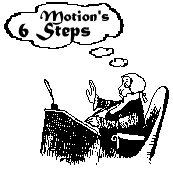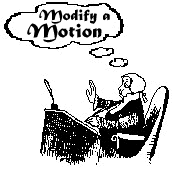Every motion requires 6 steps (with some exceptions). The
shoulds and shouldn'ts are as follows: (RONR(10th ed.),p.31-54)
STEP 1. A member stands up, is recognized, and makes a motion;
Common Mistake: Members do not stand up, do not wait to be
recognized, and typically start to discuss their motion before
completing STEP 2, STEP 3, and STEP 4 below!
STEP 2. Another member seconds the motion;
Common Mistake: The person seconding the motion dives
into the merits of the motion.
STEP 3. The presiding officer restates the motion to the
assembly;
Common Mistake: Motion is restated differently from
the wording of the maker! Beware because the motion that is adopted is
the one stated by the presiding officer, not the one stated by the
maker of the original motion.
STEP 4. The members debate the motion;
Common Mistake: Debate gets out of control in temper,
in duration, in relevance! Members talk at each other across the room
rather than through the presiding officer.
STEP 5. Presiding officer asks for the affirmative votes & then
the negative votes;
Common Mistake: The presiding officer states 'All in
favor' and fails to tell the members what to do as a matter of voting
(for example, 'say aye', 'stand up', 'raise your hand', etc.); or the
negative vote is never requested or counted!
STEP 6. The presiding officer announces the result of the
voting; instructs the corresponding officer to take action; and
introduces the next item of business.
Common Mistake: Presiding officer fails to pronounce
the result of the voting! No one is instructed to take action.
Commonly, dead silence follows because the presiding officer is lost
and stares at the assembly

























